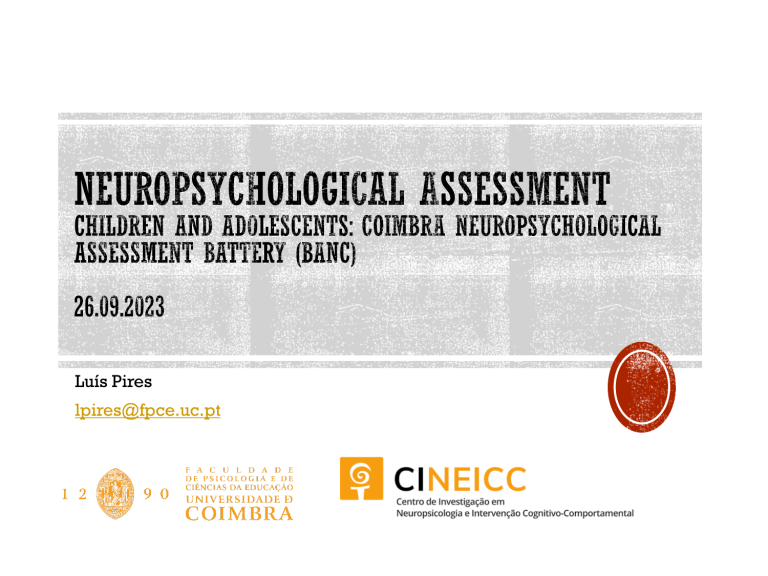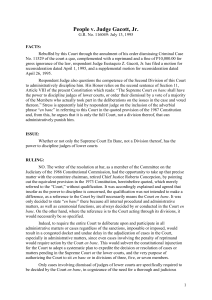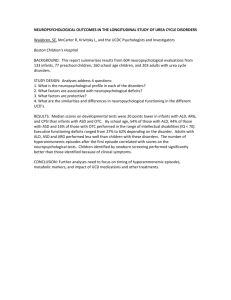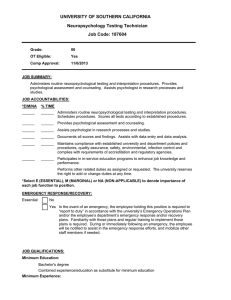
NEUROPSYCHOLOGICAL ASSESSMENT CHILDREN AND ADOLESCENTS: COIMBRA NEUROPSYCHOLOGICAL ASSESSMENT BATTERY (BANC) 26.09.2023 Luís Pires lpires@fpce.uc.pt IMCEN_Neuropsychological Assessment_Coimbra Neuropsychological Assessment Battery (BANC) Simões, M. R., Albuquerque, C. P., Pinho, M. S., Vilar, M., Pereira, M., Lopes, A. F., Seabra-Santos, M. J., Alberto, I., Lopes, C., Martins, C., & Moura, O. (2016). Bateria de Avaliação Neuropsicológica de Coimbra (BANC): Manual Técnico. [Coimbra Neuropsychological Assessment Battery (BANC): Technical manual]. Lisboa: Cegoc. [343 pags] Simões, M. R., Albuquerque, C. P., Pinho, M. S., Vilar, M., Pereira, M., Lopes, A. F., Seabra-Santos, M. J., Alberto, I., Lopes, C., Martins, C., & Moura, O. (2016). Bateria de Avaliação Neuropsicológica de Coimbra (BANC): Manual de Administração e Cotação [Coimbra Neuropsychological Assessment Battery (BANC): Administration and scoring manual]. Lisboa: Cegoc. [174 pags]. Authors: Mário R. Simões, Cristina P. Albuquerque, M. Salomé Pinho, Manuela Vilar, Marcelino Pereira, Ana Filipa Lopes, M. João Seabra-Santos, Isabel Alberto, Cláudia Lopes, Cristina Martins and Octávio Moura. Publishing company: CEGOC – TEA, Lda./Hogrefe 2 Neuropsychological Assessment Batteries (children/adolescents) • • BANC – Bateria de Avaliação Neuropsicológica de Coimbra (5-15 years) NEPSY/NEPSY-II (2007) – Developmental Neuropsychological Assessment (3-16 ys) • • • • • CANTAB – Cambridge Neuropsychological Testing Automated Battery (4-90 ys) Reitan Indiana Neuropsychological Test Battery (5-8 ys) BENCI – Battery for Neuropsychological Evaluation of Children (6-11 ys) LNNB-C – Luria-Nebraska Neuropsychological Battery for Children (8-12 ys) Halstead Neuropsychological Test Battery for Older Children (9-14 yrs) • RBANS – Repeatable Battery for the Assessment of Neuropsychological Status (1289 ys) • HRNB – Halstead-Reitan Neuropsychological Battery (> 15 ys) • LNNB – Luria-Nebraska Neuropsychological Battery (> 15 ys) • NAB – Neuropsychological Assessment Battery (18-97 ys) • KBNA – Kaplan Baycrest Neurocognitive Assessment (20-89 ys) • NIH Toolbox [comprehensive set of neuro-behavioral measures that quickly assess cognitive, emotional, sensory, and motor functions via iPad, which are being adapted for the Portuguese population] 3 Coimbra Neuropsychological Assessment Battery (BANC) • Purpose: BANC allows the assessment of basic and complex aspects related to various neurocognitive functions and skills essential to the ability to learn (at school, out of school), as well as the identification of areas of positive and impaired neurocognitive functioning. • Structure/Tests: BANC includes a set of 15 neuropsychological tests sufficiently vast and the most important neurocognitive functions (Memory, Language, Attention, Executive Functions, Orientation, Motricity and Laterality tests) that allows a comprehensive assessment of the neurocognitive development of children and adolescents. • BANC is an indispensable and complementary instrument to Wechsler Intelligence Scales (WISC-III or WPPSI-R). 4 Coimbra Neuropsychological Assessment Battery (BANC) Memory Attention and Executive Functions Language BANC Orientation Laterality Motor skills 5 Coimbra Neuropsychological Assessment Battery (BANC): TESTS Memory 1. Memory of Stories/Narrative Memory test [Memória de Histórias]: Stories A-B (5 - 9 years) OR Stories C-D (10 - 15 years); Immediate recall; Delayed recall; Delayed recognition 2. Word List Memory test [Lista de words] (5 - 15 years): Immediate recall - 1st Trial; Total Interference; Delayed Recall - Short Interval; Delayed Recall - Long Interval; Delayed recognition; Total Learning 3. Rey Complex Figure test [Fig. C. de Rey] (5 - 15 years): Copy; Delayed Recall Short Interval; Delayed Recall - Long Interval 4. Face Recognition test [Reconhecimento de Faces] (5 - 15 years): Immediate recognition; Delayed recognition 5. Corsi Block Test [Tabuleiro de Corsi] (5 - 15 years). 6 Coimbra Neuropsychological Assessment Battery (BANC): TESTS Language 6. Phonological Awareness test [Consciência Fonológica]: Elimination subtest (6 - 15 years); Substitution 1 subtest (6 - 9 years) or Substitution 2 subtest (10 - 11 years) 7. Rapid Naming test [Nomeação Rápida]: Colors subtest (5 - 6 years); Digits subtest (7 - 15 years); Shape and Colors subtest (7 - 15 years) 8. Comprehension of Instructions/ Token test adapt. [Compreensão de Instruções]: (5 - 15 years) 7 Coimbra Neuropsychological Assessment Battery (BANC): TESTS Attention/Executive Functions 9. Cancellation [Cancelamento]: 2 Signs Test (5 - 9 years) or 3 Signs Test (10 - 15 years) 10. Trails/Trail Making Test adapt. [Trilhas]: Part A (6 - 15 years); Part B (7 - 15 years) 11. Verbal Fluency [Fluência Verbal]: Semantic subtest (5 - 15 years); Phonemic subtest (7 - 15 years) 12. Tower/ Tower of London adapt. [Torre] (5 - 15 years): Trials performed; Problems Successfully Performed; Problems Successfully Performed at 1st Trial 8 Coimbra Neuropsychological Assessment Battery (BANC): TESTS Orientation 13. Orientation Test [Orientação] Motor skills 14. Motricity Board [Tabuleiro de Motricidade]: Dominant Hand; NonDominant Hand; Both Hands Laterality 15. Laterality test [Lateralidade] 9 IMCEN_Neuropsychological Assessment_Coimbra Neuropsychological Assessment Battery (BANC) • Administration: Individual (120 minutes) • Normative sample: large normative sample (N = 1104), representative of • • • • • the children and adolescents Portuguese population (5 to 15 years old) and stratified by the following criteria: Age: ≈100 children per age group (5 -15 years old); Gender: the same number of boys (n = 550) and girls (n = 554); Education/School level: ≈100 children from preschool to 10th grade; Residence Area: predominantly urban; mostly urban and predominantly rural. Geographic Region: coastal and interior. • Norms: by age 5 -15 years old. Scores: • • Standardized test results (normative groups with amplitudes of 1 year). Standardized results by Global Index (Language, Memory and Attention/Executive Functions). 10 Coimbra Neuropsychological Assessment Battery (BANC): Psychometric Properties Numerous psychometric studies (reliability and validity), unparalleled in the national panorama: Reliability: • • Internal consistency and test-retest Interscorer agreement between examiners (Rey Complex Figure test) Validity: • • • • • Confirmatory factor analysis and two-factor confirmatory factor analysis Structural invariance analysis Correlation with school results Correlation with other cognitive tests (e.g., WISC-III, MPCR) Investigations with 12 special groups (+ 500 children and adolescents tested in these special groups 11 Coimbra Neuropsychological Assessment Battery (BANC): Strengths (I) • Allows the characterization of the neurocognitive profile (and a better understanding of the preserved and / or deficient functions) of children and adolescents: ■ with typical development, ■ with Neurodevelopmental Disorders or brain injuries/dysfunctions. • Enables the identification of neurocognitive profiles (with indicators of sensitivity, specificity and abnormally low results) commonly present in Neurodevelopmental Disorders (e.g., Dyslexia, ADHD, etc.) and in other brain injuries / disorders, helping in their diagnosis. • It allows the analysis of the variability, fluctuation or developmental trajectory of the performance associated with the recovery or deterioration of one or more functions. 12 Coimbra Neuropsychological Assessment Battery (BANC): Strengths (II) • Standardized tests on the same and single measurement sample (cf. NEPSYII using two different samples), with a comparable metric for the various tests, tasks and global indexes. • BANC includes several tests / tasks that allow examining the “same” function. • With flexible application, allowing the administration of isolated tests. 13 Coimbra Neuropsychological Assessment Battery (BANC): Strengths (III) Discriminative validity of BANC scores in 12 special groups of children and adolescents: • Neurological problems (e.g., traumatic brain injury, epilepsy*); • Behavioral disorders (e.g., Hyperactivity Disorder/Attention Deficit Disorder*, Opposition*); • School problems (e.g., specific learning difficulties, Dyslexia*, intellectual giftedness); • Cognitive deficits (e.g., intellectual difficulties, borderline intellectual functioning*); • Developmental disorders (e.g., specific language developmental disorder*); • Social risk (e.g., victims of abuse or neglect, juvenile delinquency). * see publications 14 Coimbra Neuropsychological Assessment Battery (BANC): REFERENCES / MANUALS • Simões, M. R., Albuquerque, C. P., Pinho, M. S., Vilar, M., Pereira, M., Lopes, A. F., SeabraSantos, M. J., Alberto, I., Lopes, C., Martins, C., & Moura, O. (2016). Bateria de Avaliação Neuropsicológica de Coimbra (BANC): Manual Técnico. Lisboa: Cegoc. [343 páginas] ISBN: 978-972-8817-90-9 • Simões, M. R., Albuquerque, C. P., Pinho, M. S., Vilar, M., Pereira, M., Lopes, A. F., SeabraSantos, M. J., Alberto, I., Lopes, C., Martins, C., & Moura, O. (2016). Bateria de Avaliação Neuropsicológica de Coimbra (BANC): Manual de Administração e cotação. Lisboa: Cegoc. [174 páginas] ISBN: 978-972-8817-91-6 15 Coimbra Neuropsychological Assessment Battery (BANC): REFERENCES /ARTICLES (I) • • • • • • Dias, A. A., Albuquerque, C. P., & Simões, M. R. (2019). Memory and linguistic/executive functions of children with Borderline Intellectual Functioning*. Applied Neuropsychology: Child, 8(1), 76-87. doi.org/10.1080/21622965.2017.1384924 Moura, O., Albuquerque, C.P., Pinho, M.S., Vilar, M., Lopes, A. F., Alberto, I., Pereira, M., Santos, M. J. S., & Simões, M. R. (2018). Factor structure and measurement invariance of the Coimbra Neuropsychological Assessment Battery (BANC). Archives of Clinical Neuropsychology, 33(1), 66-78. doi. 10.1093/arclin/acx052 Moura, O., Pereira, M., Alfaiate, C., Fernandes, E., Fernandes, B., Nogueira, S., Moreno, J., & Simões, M.R. (2017). Neurocognitive functioning in children with developmental dyslexia and attention-deficit/hyperactivity disorder*: Multiple deficits and diagnostic accuracy. Journal of Clinical and Experimental Neuropsychology, 39(3), 296-312. doi. 10.1080/13803395.2016.1225007 Moura, O., Moreno, J., Pereira, M., & Simões, M. R. (2015). Developmental Dyslexia* and Phonological Processing in European Portuguese Orthography. Dyslexia, 21(1), 60-79. doi: 10.1002/dys.1489 doi. 10.1002/dys.1489 Moura, O., Simões, M. R., & Pereira, M. (2015). Executive Functioning in Children with Developmental Dyslexia*. The Clinical Neuropsychologist, 28, Suppl. 1, S20-41. doi. 10.1080/13854046.2014.964326 Moura, O., Simões, M. R., & Pereira, M. (2015). Working Memory in Portuguese Children with Developmental Dyslexia*. Applied Neuropsychology: Child, 4(4), 237-248. https://doi.org/10.1080/21622965.2014.885389 16 Coimbra Neuropsychological Assessment Battery (BANC): REFERENCES /ARTICLES (II) • • • • Lopes, A. F., Monteiro, J. P., Fonseca, M. J., Robalo, C. & Simões, M. (2014). Memory functioning in children with epilepsy: Frontal lobe epilepsy, childhood absence epilepsy and benign epilepsy with centro-temporal spikes*. Behavioural Neurology. Article ID 218637, 8 pages. http.//dx.org/10.1155/2014/218637 Lopes, A. F., Simões, M. R., Robalo, C. N., Fineza, I., & Gonçalves, O. B. (2010). Evaluación neuropsicológica en niños con epilepsia: Atención y funciones ejecutivas en epilepsia del lóbulo temporal*. Revista de Neurología, 5, 265-272. https://doi.org/10.33588/rn.5005.2009452 Lopes, R., Simões, M. R., & Leal, A. J.R. (2014). Neuropsychological abnormalities in children with the Panayiotopoulos syndrome point to parietal lobe dysfunction*. Epilepsy & Behaviour, 31, 50-55. doi. 10.1016/j.yebeh.2013.11.013 Lopes, R., Simões, M. R., Ferraz, L., Leal, A.R. (2014). The Mismatch Negativity Potential (MMN) as a tool for the functional mapping of temporal lobe epilepsies*. Epilepsy & Behaviour, 33, 87-93. 10.1016/j.yebeh.2014.02.017 17 BANC Face Recognition Test / Teste de Reconhecimento de Faces Evaluates the ability to recognize faces, immediately after their presentation and after a fixed time interval 18 BANC Memory for Stories test/Narrative Memory /Teste de Memória de Histórias Story A: “Birthday Party” Story B: “The day at the Beach” Story C: “The Iberian Lynx” Story D: “First aerial crossing” It evaluates long-term memory through the oral presentation of conceptual material. The effective response to the test also implies attention, listening, coding, verbal information comprehension, planning, organization and sequencing skills. 19 BANC Word List Memory test Teste de Lista de Palavras It evaluates learning and verbal memory (short-term memory, long-term memory) and specific mnesic processes, such as information encoding, retention capacity, evocation, recognition and susceptibility to interference. 20 BANC Rey-Osterrieth Complex Figure (ROCF) test Figura Complexa de Rey 21 BANC Rapid Naming / Nomeação Rápida ▪ It evaluates in an integrated way the speed of information processing, attention, self-control, the establishment of connections between visual perception and articulation, the activation and integration of semantic information, temporal sequencing, as well as long-term memory. BANC Rapid Naming / Nomeação Rápida ▪ Rapid Naming Test COLOURS ▪ Rapid Naming Test DIGITS ▪ Rapid Naming Test FORMS AND COLOURS Tests: ▪ Rapid Automatized Naming (RAN) or Rapid Serial Naming – Single Category (RSN – SC): appeal to a single semantic category - Colors or Digits ▪ Rapid Alternating Stimulus (RAS) or Rapid Serial Naming – Alternate Category (RSN – AC): imply access to two or more semantic categories - Shapes and Colors Time Errors BANC: Comprehension of Instructions /Compreensão de Instruções ▪ It essentially evaluates receptive language, at the semantic and syntactic level, as well as the processing of auditory-verbal information. ▪ It also appeals to other skills, such as working memory, short-term memory, attention and verbal and sequential reasoning. ▪ Like other Instruction Comprehension tests, with special emphasis on the Token Test. BANC Phonological Awareness / Consciência Fonológica ▪ The Elimination and ELIMINATION Substitution subtests that make up the Phonological Awareness test assess phonemic awareness through metalinguistic manipulation activities, such as the elimination or replacement of phonological segments. SUBSTITUTION BANC Verbal Fluency / Fluência Verbal ▪ The Semantic* and Phonemic* Verbal Fluency tests are considered as evaluating, mainly, the executive functions (more specifically, initiative / ability to initiate the systematic search of words and the alternation of responses; attention and self-monitoring / control of responses; flexibility; use of recovery strategies in the time available, abstract thinking), but also language (ability to quickly access the internal lexicon and search for words of specific categories stored in memory) and memory (semantic memory). • Semantic: - Animals, - Foods, - Children’s names ** Phonemic (letters, words): -P -M -R BANC TOWER (adapt Tower of London) / Torre ▪ Evaluates executive problem solving skills and planning. BANC Cancellation Test / Cancelamento de Sinais ▪ Evaluates attention (selective visual attention and sustained visual attention). BANC Trail Making Test / Trilhas Evaluates: ▪ sustained visual attention, ability to explore and visospatial sequencing (Part A) and ▪ mental flexibility and ability to inhibit responses (Part B). BANC Laterality / Lateralidade ▪ Evaluates laterality for the hand as well as the right and left recognition of itself Laterality items for the hand (example): BANC Motor Pegboard / Tabuleiro de Motricidade ▪ Evaluates manual and digital dexterity (speed, precision and coordination of hand and finger movements) TESTS Examined Functions (Laterality + Motricity) Laterality ▪laterality for the hand ▪ right and left recognition of itself Motor Pegboard Manual and digital dexterity. Velocity. Precision. Coordination of movements (hands and fingers). TESTS Examined Functions (MEMORY) Orientation General, temporal, spatial and memory orientation Face Recognition Ability to recognize faces. Memory for Stories/Narrative Memory Long-term memory. Attention skills, listening, coding, understanding verbal information, planning, organizing and sequencing. Verbal/Word List Learning and verbal memory (short-term memory, long-term memory). Specific memory processes, such as information encoding, retention capacity, evocation, recognition and susceptibility to interference. Rey Complex Figure Test Visual memory, constructive visuospatial skills. Cognitive processes associated with executive functioning (planning, organization and problem solving). Corsi Block Spatial / non-verbal memory. Visual-spatial processing. TESTS Examined Functions (ATENTION + EXECUTIVE FUNCTIONS) Semantic and Executive functions (more specifically, initiative / ability to start the Phonemic Verbal systematic search for words and alternating responses; attention and selfFluency monitoring / control of responses; flexibility; use of recovery strategies in the time available; abstract thinking). Language (ability to quickly access the internal lexicon and search for words from specific categories stored in memory). Memory (semantic memory). Tower Executive problem solving skills. Planning. Cancellation Attention (selective visual attention and sustained visual attention). Trail Sustained visual attention, the capacity for exploration and visual-spatial sequencing (Part A). Mental flexibility and the ability to inhibit responses (Part B). TESTS Examined Functions (LANGUAGE) Rapid Naming Speed of information processing. Attention. Self-control. Establishment of connections between visual perception and articulation, activation and integration of semantic information, temporal sequencing. Long-term memory. Comprehension of Instructions Receptive language, at the semantic and syntactic level, as well as the processing of auditory-verbal information. Working memory. Short term memory. Attention. Verbal and sequential reasoning. Phonological Awareness (Elimination and Substitution subtests) Metalinguistic manipulation activities, such as the elimination or replacement of phonological segments Normative Studies BANC: Normative Studies Distribution of the normative sample by age and sex (male/female) BANC: Normative Studies Distribution of the normative sample by geographical area (Coastline/Litoral, Inland/Interior) and urban area (Predominantly Urban, Moderately Urban, Predominantly Rural) BANC: Estudos Normativos Resultados padronizados para cada Teste e Índice Factorial Confirmatory Factor Analysis Confirmatory Factor Analysis ▸ Confirmatory Factor Analysis and Invariance Analysis o IBM SPSS Amos 20 o maximum likelihood estimation) o Matrix of covariance ▸ Tests o Memory, Language and Attention Moura, O., Albuquerque, C.P., Pinho, M.S., Vilar, M., Lopes, A. F., Alberto, I., Pereira, M., Santos, M. J. S., & Simões, M. R. (2018). Factor structure and measurement invariance of the Coimbra ▸ Sample Neuropsychological Assessment Battery (BANC). Archives of o 7 to 15 years; N = 833 Clinical Neuropsychology, 33(1), 66-78. doi:10.1093/arclin/acx052 Confirmatory Factor Analysis CFI RMSEA SRMR 3 Fatores Correlacionados .960 .042 .045 3 Fatores Não Correlacionados .880 .073 .125 AFC Bifatorial .921 .062 .077 4 Fatores (Memória Verbal, Memória Visual, Linguagem e Atenção/FE) 5 Fatores (Memória Verbal, Memória Visual, Linguagem, Atenção e FE) modelo inadmissível r > 1 Memória Visual e Atenção/Funções Executivas modelo inadmissível r > 1 Atenção e Funções Executivas Confirmatory Factor Analysis Invariance Analysis 7-9 years vs. 10-15 years CFI SRMR RMSEA 2 df df 2 CFI Configural .960 .059 .031 565.255 318 Métrica .958 .064 .030 590.153 335 17 24.898, p = .097 -.002 Escalar .941 .064 .035 719.123 355 37 153.868, p <.001 -.019 Escalar (parcial) .960 .064 .029 593.156 354 36 27.901, p = .831 .000 Administration Process BANC Tests: Administration order First Part Orientation Second Part Third Part Fourth Part Memory for Stories Rey Complex Figure Word List (Immediate recall) (Copy) (Immediate Recall) Tower Semantic Verbal Fluency (Learning List; Interference List; Free Delayed Recall – Short Interval) Laterality Signal Cancellation Rey Complex Figure Trail Face Recognition Rapid Naming Phonemic Verbal Fluency Face Recognition (Delayed Recall) Memory for Stories (Delayed Recall and Recognition) (Delayed Recall – Short Interval) Comprehension of Instructions Phonological Awareness Rey Complex Figure (Delayed Recall – Long Interval) Corsi Block Motor Pegboard Word List (Free Delayed Recall – Long Interval; Delayed Recognition) Results Interpretation Standardized Scores/Results: Classification ▸ BANC allows the conversion of the following results: o Conversion/Transformation of Raw Scores into Standardized Scores (M = 10; SD = 3) for each of the tests according to the age of the child or adolescent o Conversion/Transformation of the sum of the Standardized Scores of some tests on Global Indexes (M = 100; SD = 15 and percentile note) of Memory, Language, and Attention/Executive Functions (Indexes). Context of Interpretation of Results ▸ INTERVIEW(S): o Reason for the Assessment o History (developmental, clinical/medical, educational/school, family, social, emotional, …) o Medical or school exams and reports ▸ Use of several interlocutors: o Parents o Teachers o Child or adolescent Context of the Interpretation of the Results ▸ Integration of results and information obtained in the remaining evaluation protocol carried out: o WISC-III* or WPPSI-R o Other tests/instruments: D2, Reading tests, Conners, CBCL, TRF, SCICA, YSR, CDI, STAI-C, PHSCS-2, ... ▸ Behavior Observation: o Important in the qualitative analysis of the performances in the different BANC tests NEUROPSYCHOLOGICAL ASSESSMENT CHILDREN AND ADOLESCENTS: ATTENTION 26.09.2023 Luís Pires lpires@fpce.uc.pt Attention • Attention is a cognitive experience that is self-evident, yet difficult to characterize. “Everyone knows what attention is. It is the taking possession by the mind in clear and vivid form, of one out of what seem several simultaneously possible objects or trains of thought...It implies withdrawal from some things in order to deal effectively with others.” William James, Principles of Psychology (1890) Attention is the cognitive processs of selectvely concentrating on one aspect of the external or internal environment while ignoring other aspects. Attention Humans are constantly flooded with an infinite number of signals from both outside and within. Attention frames this input regarding the available capacity. Attentional processes facilitate cognitive and behavioural performance in several ways: 1. Serve to reduce the amount of information that will receive additional focused and sustained processing by the brain. 2. Enable a larger amount of information to receive additional processing. 3. Facilitate the selection of salient information and the allocation of cognitive processing appropriate to that information. Attention Humans have a limited attentional capacity. We cannot process an infinite amount of information simultaneously. Factors that limit attentional performance: 1. Structural (affect global attention)– memory, neural processing speed, the nature of temporal– spatial representations. 2. Energetic– arousal (energetic state) and effort (reinforcement–motivational influences). Attention Attention - Theories • Attention affects our perception… CHANGE BLINDNESS Attention - Theories CHANGE BLINDNESS Failing to notice big changes in the environment. Demonstrates limited capacity to take in all aspects of a scene at the same time (in the example, focus on giving directions does not allow to focus on the person asking for directions) Attention - Theories INATTENTIONAL BLINDNESS Attention - Theories • Attention may be needed to bind together different aspects of conscious perception (e.g. shape and color, sound and vision) INATTENTIONAL BLINDNESS Failing to see visible objects when our attention is directed elsewhere Attention - Theories Donald Broadbent Attention - Theories ‘Early Selection’ Attention Model ‘Early Selection’ and ‘Leaky Filter’ Attention Model Attention - Theories ‘Late Selection’ Attention Models • Selection does note occur until meaning has been processed. NEUROPSYCHOLOGICAL ASSESSMENT CHILDREN AND ADOLESCENTS: NEUROPSYCHOLOGICAL ASSESSMENT OF ATTENTION –CANCELLATION TEST 26.09.2023 Luís Pires lpires@fpce.uc.pt ATTENTION Cancelation Tests 1000 squares 25 x 40 Cancellation test (BANC) signs – 5-9 years old Neuropsychological Assessment – Divided 2Attention 3 signs 10-15 years old ATTENTION Cancellation test (BANC) Neuropsychological Assessment – Divided Attention Administration Video (7mins) – Ana Filipa Lopes (Centro de Desenvolvimento da Criança Torrado da Silva do Hospital Garcia de Orta) e Ricardo (7 anos) Practical Exercise in Class ATTENTION Cancellation test (BANC) Neuropsychological Assessment – Divided Attention Time Limit – 10 minutes Measures: - total number of hits (items correctly selected, each 1 point) - total number of errors (items wrongly selected – false positives) - total number of omissions (not selecting the target symbol – false negatives) The total score (maximum 37.5 points) is calculated by: The higher the total scores, the better the subjects’ performance. ATTENTION Cancellation test (BANC) Neuropsychological Assessment – Divided Attention Other main outcomes: Performance monitorization (every 2 mins or every 5 mins) – allows better differentiation between sustained and selective attention processes, between more automatic or more controlled attention processes. The Work Efficiency (WE) it’s calculated by: WE = H - (E+O). It is a measure of the subject’s work quality; The Dispersion Index (DI), corresponding to the percentage of mistakes committed during the test, allows to understand if the results obtained on the WE were influenced by a response pattern of impulsivity (errors) or inattention (omissions). This index is calculated by: THANK YOU FOR YOUR ATTENTION! (OBRIGADO PELA VOSSA ATENÇÃO!)




